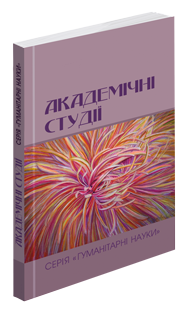Abstract
The article is focused on the peculiarities of the poetics of Eros and Thanatos in Ivan Franko’s short stories “The Jay’s Wing” and “As in a Dream”. The genesis of the selected works is clarified and the factors that influenced their appearance are identified. An in-depth analysis of the theoretical and methodological foundations of Ivan Franko’s artistic philosophy is carried out and the intricate interaction between life and death, love and destruction in his works is highlighted. The use of symbols, which are one of the most expressive aspects of the functional dimension of Franko’s prose, is analyzed. Particular attention is paid to the concepts of Eros, which are found in the descriptions of romantic and sexual relationships or in manifestations of life force, and Thanatos, or the desire for death and destruction, which is deservedly considered one of the recurring themes in Franko’s stories. The poetics of Eros and Thanatos in Franko’s short fiction demonstrates the awareness of the inevitability of death and its pervasive influence on a person, and also demonstrates the lust for life, creation, and love. The results obtained from the analysis of the selected short stories contribute to a deeper understanding of the overall scope of Franko’s short fiction. The perception and criticism of Franko’s works have evolved over time, initially focusing on social and class conflicts, but increasingly recognizing the psychological and symbolic depth of his prose. Contemporary literary criticism now evaluates Ivan Franko’s creative heritage as a significant contribution not only to Ukrainian but also to world literature, since Franko’s prose is often associated with universal issues. Thus, Ivan Franko’s short prose goes beyond traditional literary analysis, providing rich material for reflection on the eternal themes of Eros and Thanatos. This makes Franko’s works relevant and significant for all time, inviting readers and researchers to reflect on the complexity of human existence through the lens of the mastery of his prose.
References
Голод Р. Іван Франко та літературні напрями кінця ХІХ – початку ХХ століття. Івано-Франківськ: Лілея-НВ, 2005. 288 с.
Денисюк І. Літературознавчі та фольклористичні праці: У 3 т., 4 кн. – Львів: Літературна агенція «Піраміда», 2005. Кн. 2. 527 с.
Коцур В. (ред.) та інш. Енциклопедичний словник символів культури України. 5-е вид. Корсунь-Шевченківський: ФОП Гавришенко В. М., 2015. С. 39.
Легкий М. Проза Івана Франка: поетика, естетика, рецепція в критиці: монографія / наук. ред. Євген Нахлік; ДУ «Інститут Івана Франка НАН України; Львівський національний університет імені Івана Франка. Львів, 2021.
Маланюк Е. Франко незнаний. Книга спостережень. Проза. Торонто: Гомін України, 1962. С. 81–90.
Сеник Л. Психологізм художньої прози Івана Франка в контексті нових естетичних тенденцій: новели «Син Остапа», «Мій злочин», «Неначе сон» // Укр. літературознавство. Львів: ЛНУ імені Івана Франка, 2019. Вип. 84. С. 50–58.
Тихолоз Б. Ерос versus Танатос (філософський код “Зів’ялого листя”) Львів: Видавничий центр ЛНУ ім. І. Франка, 2004. 89 с. (Серія: «Дрібненька бібліотека»; Ч. 11).
Тихолоз Б., Тихолоз Н. «Голос духа чути скрізь...» (Міфологічні персонажі в структурі Франкового тексту) // Міфопоетичні образи в художньому світі Івана Франка (ейдологічні нариси) / Катерина Дронь, Богдан Тихолоз, Наталія Тихолоз, Алла Швець. Львів, 2007. С. 170–231.
Франко І. Зібрання творів: у 50 т. Київ: Наукова думка, 1979. Т. 22. 520 с.
Фройд З. Основні категорії психоаналізу // Всесвіт. 1991. № 5. С. 164–170.
Fernie W. Precious Stones for Curative Wear. Bristol: John Wright & Co. 1907. pp. 248–249
Twigs W. Chrysanthemum, Illustrated edition, London, England: Reaktion Books. 2020. p. 23.

